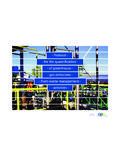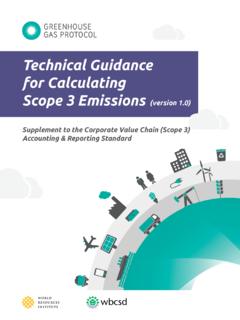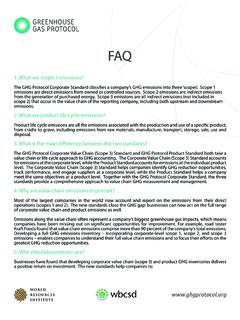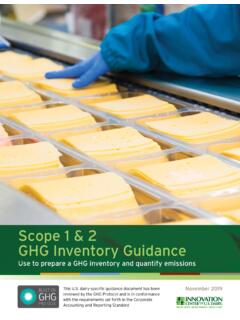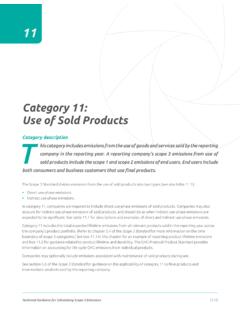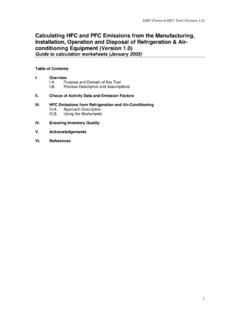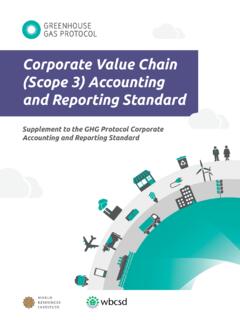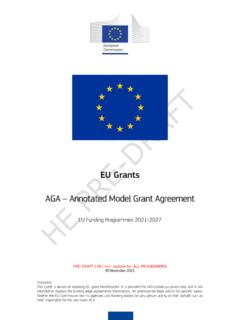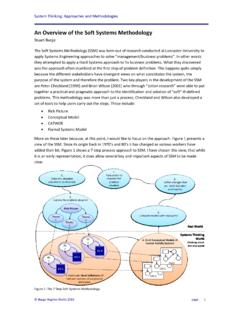Transcription of Technical Guidance
1 Technical Guidance for Calculating Scope 3 Emissions Supplement to the Corporate Value Chain (Scope 3)Accounting & Reporting StandardCO2CH4SF6N2 OHFCsPFCspurchased electricity, steam, heating & cooling for own usepurchased goods and servicescapital goodsfuel and energy related activities transportation and distributionwaste generated in operationsbusiness traveltransportation and distributionprocessing of sold productsuse of sold productsend-of-life treatment of sold productsleased assetsfranchisesemployee commutingleased assetsinvestmentscompany facilitiescompany vehicles(version )This document was developed in partnership with the Carbon Trust. GHG Protocol and Carbon Trust TeamMartin Barrow, Carbon TrustBenedict Buckley, World Resources InstituteTom Caldicott, Carbon TrustTom Cumberlege, Carbon Trust John Hsu, Carbon TrustScott Kaufman, Carbon TrustKevin Ramm, Carbon TrustDavid Rich, World Resources InstituteWill Temple-Smith, Carbon TrustWorld Resources Institute ContributorsCynthia Cummis, World Resources InstituteLaura Draucker, World Resources InstituteSofia Khan, World Resources Institute Janet Ranganathan, World Resources InstituteMary Sotos, World Resources InstituteCopyright World Resources Institute & World Business Council for Sustainable Development, 2013 Technical Guidance for Calculating Scope 3 Emissions [03] AcknowledgmentsThe GHG Protocol is grateful to the following people and organizations for providing written comments on an earlier draft of this document.
2 Gorm Kj rb ll, AB ElectroluxKatrina Destree Cochran, Alcatel-LucentIsabel Bodlak, Allianz SEArturo Cepeda, LtdGeorge Vergoulas, ArupNicola Paczkowski, BASF SEWill Schreiber, Best Food ForwardRicardo Teixeira and Sara Pax, Bluehorse AssociatesMarshall Chase, BSR Clean Cargo Working GroupFrances Way, Carbon Disclosure ProjectPeggy Foran, The Climate RegistryChristopher Gleadle, The CMG ConsultancyMichael Van Brunt, Covanta Energy CorporationDr. Klaus Hufschlag and Patric P tz, Deutsche Post DHLRob Rouse, The Dow Chemical CompanyDawn Rittenhouse, DuPontChris Brown and Bernhard Gr nauer, AGCorinne Reich-Weiser, EnvianceDaniel Hall, ForestEthicsConcepci n Jim nez-Gonz lez, GlaxoSmithKlineThaddeus Owen, Herman MillerDon Adams, Keystone FoodsDr. John Andrews, Landcare ResearchMaria Atkinson, Lend Lease Sustainability Solutions Jordi Avelleneda and Mads Stensen, Maersk Line and DamcoDavid B.
3 Goldstein, Natural Resources Defense CouncilJohannes Partl and Duncan Noble, PE International and Five Winds InternationalJorge Alberto Plauchu Alcantara, Plauchu ConsultoresNick Shufro, PricewaterhouseCoopers LLPW illiam Lau, SGS-CSTC Standards Technical Services Co., LtdZolt n Hajdu, Soltub Kloow, TetraPakYoshikazu Kato, The Japanese Gas AssociationYutaka Yoshida, Tokyo Gas Co., Douglas, UK Department of Environment, Food and Rural Affairs (Defra)Matt Clouse, John Sottong, and Jesse Miller, Environmental Protection AgencyBryan Steverson, General Services AdministrationKeith James, Waste & Resources Action Programme (WRAP)Nisitha DasanayakeTable of ContentsIntroduction 05 CATEGORIES 1: Purchased Goods and Services 202: Capital Goods 363: Fuel- and Energy-Related Activities Not Included in Scope 1 or Scope 2 384: Upstream Transportation and Distribution 495: Waste Generated in Operations 726: Business Travel 817: Employee Commuting 878: Upstream Leased Assets 949: Downstream Transportation and Distribution 10210: Processing of Sold Products 10611: Use of Sold Products 11312: End-of-Life Treatment of Sold Products 12513: Downstream Leased Assets 12814: Franchises 13015: Investments 136 APPENDICES A.
4 Sampling 153B: Scenario uncertainty in calculating emissions from the use of sold products 158C: Calculating emissions intensity metrics 160D: Calculation formula summary tables 162 Technical Guidance for Calculating Scope 3 Emissions [04] Technical Guidance for Calculating Scope 3 Emissions [05] IntroductionAn effective corporate climate change strategy requires a detailed under-standing of a company s greenhouse gas (GHG) emissions. Until recently, companies have focused on emissions from their own operations under scope 1 and scope 2 of the GHG Protocol. Increasingly companies understand the need to also account for GHG emissions along their value chains and product portfolios to comprehensively manage GHG-related risks and opportunities. The GHG Protocol Corporate Value Chain (Scope 3) Accounting and Reporting Standard (referred to as the Scope 3 Standard), the parent document to this Guidance , offers an internationally accepted method to enable GHG management of companies value chains.
5 This Guidance document serves as a companion to the Scope 3 Standard to offer companies practical Guidance on calculating their scope 3 emissions. It provides information not contained in the Scope 3 Standard, such as methods for calculating GHG emissions for each of the 15 scope 3 categories, data sources, and worked refer to the Scope 3 Standard for requirements and Guidance related to scope 3 accounting and reporting. IntroductionTechnical Guidance for Calculating Scope 3 Emissions [06] Figure [I] Overview of GHG Protocol scopes and emissions across the value chainCO2CH4SF6N2 OHFCsPFCspurchased electricity, steam, heating & cooling for own usepurchased goods and servicescapital goodsfuel and energy related activities transportation and distributionwaste generated in operationsbusiness traveltransportation and distributionprocessing of sold productsuse of sold productsend-of-life treatment of sold productsleased assetsfranchisesemployee commutingleased assetsinvestmentscompany facilitiescompany vehiclesNF3 Scope 3 INDIRECTCO2CH4SF6N2 OHFCsPFCspurchased electricity, steam.
6 Heating & cooling for own usepurchased goods and servicescapital goodsfuel and energy related activities transportation and distributionwaste generated in operationsbusiness traveltransportation and distributionprocessing of sold productsuse of sold productsend-of-life treatment of sold productsleased assetsfranchisesemployee commutingleased assetsinvestmentscompany facilitiescompany vehiclesCO2CH4SF6N2 OHFCsPFCspurchased electricity, steam, heating & cooling for own usepurchased goods and servicescapital goodsfuel and energy related activities transportation and distributionwaste generated in operationsbusiness traveltransportation and distributionprocessing of sold productsuse of sold productsend-of-life treatment of sold productsleased assetsfranchisesemployee commutingleased assetsinvestmentscompany facilitiescompany vehiclesCO2CH4SF6N2 OHFCsPFCspurchased electricity, steam.
7 Heating & cooling for own usepurchased goods and servicescapital goodsfuel and energy related activities transportation and distributionwaste generated in operationsbusiness traveltransportation and distributionprocessing of sold productsuse of sold productsend-of-life treatment of sold productsleased assetsfranchisesemployee commutingleased assetsinvestmentscompany facilitiescompany vehiclesCO2CH4SF6N2 OHFCsPFCspurchased electricity, steam, heating & cooling for own usepurchased goods and servicescapital goodsfuel and energy related activities transportation and distributionwaste generated in operationsbusiness traveltransportation and distributionprocessing of sold productsuse of sold productsend-of-life treatment of sold productsleased assetsfranchisesemployee commutingleased assetsinvestmentscompany facilitiescompany vehiclesCO2CH4SF6N2 OHFCsPFCspurchased electricity, steam.
8 Heating & cooling for own usepurchased goods and servicescapital goodsfuel and energy related activities transportation and distributionwaste generated in operationsbusiness traveltransportation and distributionprocessing of sold productsuse of sold productsend-of-life treatment of sold productsleased assetsfranchisesemployee commutingleased assetsinvestmentscompany facilitiescompany vehiclesCO2CH4SF6N2 OHFCsPFCspurchased electricity, steam, heating & cooling for own usepurchased goods and servicescapital goodsfuel and energy related activities transportation and distributionwaste generated in operationsbusiness traveltransportation and distributionprocessing of sold productsuse of sold productsend-of-life treatment of sold productsleased assetsfranchisesemployee commutingleased assetsinvestmentscompany facilitiescompany vehiclesCO2CH4SF6N2 OHFCsPFCspurchased electricity, steam.
9 Heating & cooling for own usepurchased goods and servicescapital goodsfuel and energy related activities transportation and distributionwaste generated in operationsbusiness traveltransportation and distributionprocessing of sold productsuse of sold productsend-of-life treatment of sold productsleased assetsfranchisesemployee commutingleased assetsinvestmentscompany facilitiescompany vehiclesReporting companyUpstream activitiesDownstream activitiesCO2CH4SF6N2 OHFCsPFCspurchased electricity, steam, heating & cooling for own usepurchased goods and servicescapital goodsfuel and energy related activities transportation and distributionwaste generated in operationsbusiness traveltransportation and distributionprocessing of sold productsuse of sold productsend-of-life treatment of sold productsleased assetsfranchisesemployee commutingleased assetsinvestmentscompany facilitiescompany vehiclesCO2CH4SF6N2 OHFCsPFCspurchased electricity, steam.
10 Heating & cooling for own usepurchased goods and servicescapital goodsfuel and energy related activities transportation and distributionwaste generated in operationsbusiness traveltransportation and distributionprocessing of sold productsuse of sold productsend-of-life treatment of sold productsleased assetsfranchisesemployee commutingleased assetsinvestmentscompany facilitiescompany vehiclesScope 1 DIRECTS cope 2 INDIRECTS cope 3 INDIRECTCO2CH4SF6N2 OHFCsPFCspurchased electricity, steam, heating & cooling for own usepurchased goods and servicescapital goodsfuel and energy related activities transportation and distributionwaste generated in operationsbusiness traveltransportation and distributionprocessing of sold productsuse of sold productsend-of-life treatment of sold productsleased assetsfranchisesemployee commutingleased assetsinvestmentscompany facilitiescompany vehiclesCO2CH4SF6N2 OHFCsPFCspurchased electricity, steam.
